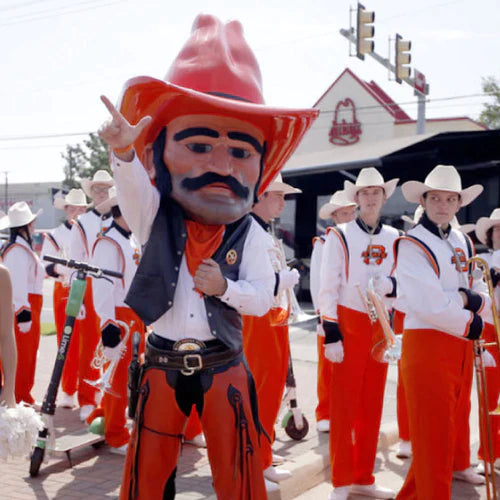Your Cart is Empty
DESIGNED IN SEATTLE | MADE IN SEATTLE
DESIGNED IN SEATTLE | MADE IN SEATTLE

HOW TO MAKE A MASCOT HEAD - OSU PISTOL PETE
August 30, 2019 3 min read
Platform: Oklahoma State University Mascot – Pistol Pete
Design: OSU
Common Fibers was selected to re-build Oklahoma State University beloved mascot Pistol Pete. The originals were built by Disney in the 1960's out of fiberglass and weighed in at over 50lbs. Once finished, the new carbon fiber Pistol Pete weighed in at only 25lbs.
Idea Creation


Every year, two OSU students are chosen for the highly sought-after position of 'Pistol Pete' - the school's mascot. The price they pay for that honor? Running around for hours at a time with a massive 50 pound weight on their head. The school came to us with two requirements: make it as light as you can and make it lookexactlylike the original, down to the wrinkles. Fortunately the woman who painted the original Pete is still around, so she would take care of the final paint and facial hair for us.
In order to achieve this, we used a 3D scanner to map the shape of Pete's hat and head. The rendering was then used to to inform the CAD and CAM for our foam plug. Want to learn more about designing custom carbon fiber parts? Check out our post ondesigning composite parts for an introduction to our design process!
Plug Creation
Materials: 15lb Tooling Foam, Duratec Sanding Primer



The plug was machined on our 4-Axis CNC, using 15lb tooling foam. The head was divided into halves, and the hat into a cone with the upper part of the brim and separate mold for the underside of the brim.Pete's ears were deleted from the plug in oder to avoid negative geometry - a feature that would prevent the plug (and subsequent parts) from being removed from the mold. We instead opted to 3D print the ears as components to be individually post bonded to the final part before it was sprayed with sanding primer. The intricate details of the plug were sanded as little as possible to maintain the correct form. For more information on building a plug, check out our process blogs onsplash plug fabrication,machining a foam plug, andplug finishing.
Mold Creation
Materials:Tooling Gelcoat,Fiberglass Chopped Strand Mat,Polyester Tooling Resin

Because these molds had such intricate details, we split the mold lamination into two stages. The first we used only fiberglass string, or 'toes', to reinforce tight radii and a very thin layer of strand mat. During the second stage we fiberglassed the bulk of the mold and fortified it with 2'x4's. You can learn more about these steps in our posts onspraying gelcoat, themold lamination process, andhow to finish your mold.
Layup Process
Materials: 6K Carbon Fiber Fabric, Epoxy Resin, 3mm Foam Core


Pistol Pete required four separate VARTM infusion lay-ups to create the two halves of his face, the top of the hat and bottom brim. A wet lay-up was performed to affix the hat along with some adhesive. All told, it used 25 yards of carbon fiber, 75 square feet of vacuum bag, 100 feet of tacky tape, and over 16 liters of polyester resin. Careful attention was paid to tucking the carbon into Pete’s intricate facial features to avoid bridging and subsequent weak points. The face and hat top presented an interesting infusion challenge for the lay-up team: How to infuse evenly across a deep cavity with a relatively small diameter top surface? Strategic placement of extra flow media, carbon ‘damming’ (i.e. lack of flow media) and tube placement was critical to their success.
Check out our blog posts for an in depth look at the VARTM infusion process and stay tuned for a post strategies for an infusion on an oddly shaped part!
Part Finishing
Materials: Duratec Sanding Primer, 3D Printed Components, Urethane Adhesive


Pete required a secondary wet lay-up to join the two sides of the face and upper and lower parts of his hat. We also used a wet lay-up to mount a helmet inside for the wearer. The 3D printed ears were mounted with a urethane adhesive before the whole part was sprayed with sanding primer. Pete's wrinkles were carved into the primer after it was sprayed. You can learn more about the these steps in our posts ontrimming carbon fiber andhow to do a wet lay-up.
Final Build
Common fibers was only responsible spraying primer and sanding Pistol Pete smooth. The rest of the magic occurred back in Stillwater, Oklahoma. Since Disney created the original heads back in the sixties, the same woman has been taking care of them ever since. She intricately hand paints each detail and glues on all the hair. Regularly, she touches up any dings and scratches. She is aptly called "the Mother of Pistol Pete."

Subscribe
Sign up to get the latest on sales, new releases and more …
